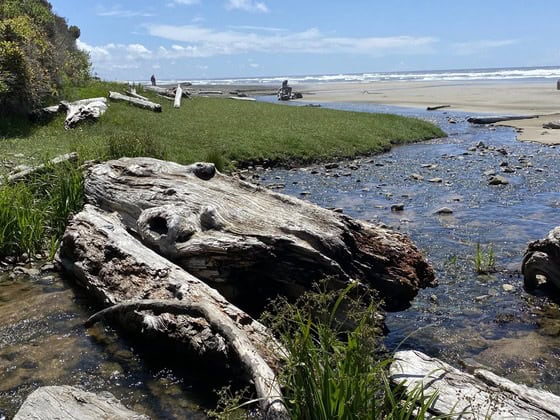SALEM – The Oregon Department of Land Conservation and Development’s (DLCD) Coastal Management Program and the Confederated Tribes of Siletz Indians (CTSI) announce $4.85 million in Bipartisan Infrastructure Law funding for the conservation of an iconic property along Oregon’s coastal shoreline. This project aims to protect a 42-acre property on the central coast of Oregon, safeguarding its unique ecological and cultural significance.
The National Oceanic and Atmospheric Administration (NOAA) recently announced 22 award recommendations nationwide totaling $59.8 million in funding for coastal management programs. This funding is intended to increase resilience through landscape-scale habitat restoration and conservation projects. The $4.85 million awarded to Oregon will provide funding necessary for CTSI to acquire the property which supports some of the rarest and most ecologically-significant habitats on the Oregon coast, rich marine and terrestrial species diversity, and unique habitat corridors — from the ocean to upland rainforest —critical for species migration and connectivity. These unique habitat qualities are of equal cultural importance to CTSI, bolstering the resilience of the Tribe and coastal community.
With its nearshore and marine protected habitats, freshwater streams, diverse shoreline shrub and forest habitat, and unique Sitka spruce wetlands, this property will be the centerpiece of a regional tribal effort focused on invigorating cultural traditions. The property is located within a region that was historically (pre-contact) heavily settled by the Alsea band of CTSI. The Alsea people were seal and sea lion hunters who fished the nearshore habitats.

While the Siletz people have been stewarding Oregon’s central coast since time immemorial, CTSI experienced a loss of over 100 miles of coastal shoreline ownership nested within 1.1 million acres of original reservation land. With this funding, CTSI will regain ownership of this 42-acre property and conserve the land as an anchor for cultural resilience and regional collaboration in nearshore, forest, and wetland conservation and education. The Siletz people will provide opportunities for education and outreach about the richness of the Oregon coast, the central role of the tribes in its stewardship, and the value of conserving lands and waters.
“On behalf of the Confederated Tribes of Siletz Indians, I am profoundly grateful for the announcement of this grant, which marks a significant milestone in our ongoing efforts to preserve our ancestral lands and cultural heritage. With this support, the Confederated Tribes of Siletz Indians will acquire and safeguard a 42-acre beachfront property that holds immense ecological, cultural, and historical significance. We recognize the urgent need to protect this pristine coastline, not only for the benefit of our tribe but also for the broader community and future generations. By acquiring and managing this property in perpetuity, we honor its sacredness, foster biodiversity, and promote resilience in the face of climate change. This grant not only empowers us to fulfill our stewardship responsibilities but also strengthens our partnership with the state of Oregon and McKenzie River Trust in achieving coastal resilience and conservation goals. On behalf of the Confederated Tribes of Siletz Indians, I extend our deepest gratitude to all those who have supported this endeavor,” said Delores Pigsley, Tribal Chairman of the Confederated Tribes of Siletz Indians.
“We are honored to have this opportunity to partner with the Confederated Tribes of the Siletz Indians, McKenzie River Trust, and Lincoln County to preserve this important cultural and ecological property. The strength of this partnership was instrumental in applying for this highly competitive national funding source. This marks our second collaborative endeavor with the Confederated Tribes of the Siletz Indians to reclaim lands of profound cultural significance and restoring them to tribal ownership,” said Lisa Phipps, Oregon Coastal Management Program/DLCD Manager.
Oregon’s central coast region, known for its pristine landscapes and vital ecosystems, faces increasing threats from development and climate change. Partners invested in this work are building on the conservation of this land towards a central coast conservation and education program that strengthens community resilience. Lincoln County, the Lincoln County Board of Commissioners, and the Lincoln County Department of Planning and Development have been strong supporters of this project and CTSI. With established relationships and shared goals, the County and CTSI leveraged their initial investments to move this project forward.
“Thank you to DLCD, CTSI, and the numerous partners whose collective efforts applied for this important funding. Lincoln County is proud to have played a contributing role in helping protect this property,” said Lincoln County Commissioner Kaety Jacobson. “Our deep appreciation goes out to the exceptional team of collaborators that come together for crucial conservation initiatives like this.”
The partnership between DLCD, CTSI, McKenzie River Trust, and Lincoln County is a critical step towards preserving this invaluable coastal environment. McKenzie River Trust plays a vital role in building this conservation partnership and providing technical support for tribal led projects such as this one.
“I’m incredibly pleased to witness this historic funding support [this] project” said Margaret Treadwell, Central Coast Conservation Program Manager, McKenzie River Trust. “McKenzie River Trust is honored to continue working in support of the Confederated Tribes of Siletz Indians’ shared goals of conserving special landscapes and restoring cultural connections through the return of important places back to the Tribe.”
Photo Credit: Lincoln County
###
NOAA’s Habitat Protection and Restoration Funding Recommendations
In April 2024, NOAA announced the distribution of $59.8 million for state and territory coastal management programs and $15 million for national estuarine research reserves from the Bipartisan Infrastructure Law and Inflation Reduction Act funding to support coastal habitat restoration planning, engineering, and design projects, and implementation and land conservation projects. This slate of 22 projects across 16 states (coastal zone management) and eight projects across seven states (research reserves) will advance the resilience of their coastal communities. Recommended projects will increase community resilience through habitat restoration, habitat restoration planning, engineering and design, and ecosystem conservation.
 About The Oregon Coastal Management Program
About The Oregon Coastal Management Program
Oregon is one of 34 states to have a nationally recognized Coastal Management Program established by the Coastal Zone Management Act of 1972. The Oregon Coastal Management Program aims to protect coastal and ocean resources, and ensure livable, resilient communities on the Oregon coast. The Oregon Department of Land Conservation and Development is the lead agency in the coastal program network, which also includes 11 state agencies and 42 city and county governments. Financial assistance for OCMP is provided by the Coastal Zone Management Act of 1972, as amended, administered by the Office for Coastal Management, National Oceanic and Atmospheric Administration.
 Oregon’s statewide land use planning program
Oregon’s statewide land use planning program
Ooriginated in 1973 under Senate Bill 100 — it protects farm and forest lands, conserves natural resources, promotes livable communities, facilitates orderly and efficient development, helps coordination among local governments, and enables community engagement.
The program affords all Oregonians predictability and sustainability to the development process by ensuring allocation of urban land for industrial, commercial, and housing development. The Department of Land Conservation and Development (DLCD) administers the program. A seven-member volunteer citizen board known as the Land Conservation and Development Commission (LCDC) guides DLCD.
Under the program, all cities and counties have adopted comprehensive plans that meet mandatory state standards. The standards are 19 Statewide Planning Goals that address land use, development, housing, transportation, and conservation of natural resources. Technical assistance in the form of grants to local jurisdictions is a key element of the program.


